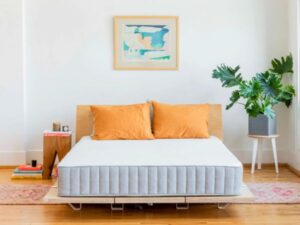Raising a bed without legs may seem like an unusual idea, but it has its benefits. Whether you’re looking to increase storage space, improve accessibility, or simply enhance the overall aesthetics of your bedroom, elevating your bed can be a practical and stylish solution. In this article, we will explore various methods of How To Raise A Bed Without Legs, providing you with simple and cost-effective alternatives to traditional bed frames.
Assessing the Need: Determining the Right Height
Before you embark on raising your bed, it’s crucial to assess your specific needs and determine the ideal height. Consider factors such as storage requirements, personal mobility, and any existing furniture or fixtures in your room. By taking these factors into account, you can ensure that the raised bed will meet your requirements and blend seamlessly with your bedroom decor.
DIY Bed Risers: Simple and Cost-Effective Solutions
One popular approach to raising a bed without legs is by using DIY bed risers. These simple and cost-effective solutions can be easily made using materials readily available at home improvement stores. By elevating your bed with bed risers, you can create additional storage space underneath while maintaining stability and support.

Utilizing Furniture Blocks or Bricks
If you’re looking for a quick and inexpensive option, consider utilizing furniture blocks or bricks to raise your bed. These sturdy and readily available materials can be placed strategically under each bed leg, providing the desired height and stability. However, it’s important to ensure that the blocks or bricks are securely positioned to prevent any accidents or wobbling.
Elevating with Bed Wedges or Foam Inserts
Bed wedges or foam inserts are another practical solution for raising a bed without legs. These specially designed accessories can be placed under the mattress to create an inclined surface. Bed wedges are particularly beneficial for those seeking additional comfort, such as individuals with acid reflux or breathing difficulties. They also offer a temporary elevation option that can be adjusted or removed as needed.
Creative Options: Using Storage Containers or Wooden Crates
For a unique and stylish approach to raising your bed, consider using storage containers or wooden crates. These versatile options not only provide height but also offer extra storage space for items like clothes, shoes, or bedding. By selecting aesthetically pleasing containers or crates, you can turn a functional solution into a design statement.

Adjustable Bed Frame Alternatives
If you desire the flexibility of adjustable bed frames without the legs, there are alternative options available. Adjustable bed risers or platforms provide the functionality of adjusting the height and angle of your bed, allowing you to find the most comfortable position for sleeping or lounging.
The Pros and Cons of Raising Your Bed
Raising your bed without legs has its advantages and disadvantages. Understanding the pros and cons is essential to making an informed decision. Benefits include increased storage space, improved accessibility, and enhanced room aesthetics. However, potential drawbacks may include stability concerns, noise issues, and the need for additional mattress support.
Safety Considerations and Stability Tips
When raising a bed without legs, safety should be a top priority. Ensure that the chosen method provides adequate stability and support. It’s important to consider weight limits, distribute weight evenly, and periodically check for any signs of wear or instability. Additionally, take precautions to prevent slipping or tripping hazards.

Enhancing Comfort: Choosing the Right Mattress for a Raised Bed
Selecting the right mattress for a raised bed is crucial to ensure optimal comfort. Consider factors such as mattress thickness, firmness level, and support requirements. Additionally, verify that the chosen mattress is compatible with the raised bed setup to prevent any compatibility issues or compromises in comfort.
Maintaining Aesthetics: Concealing Bed Risers or Supports
If you prefer a seamless and polished look for your raised bed, consider concealing bed risers or supports. Various methods, such as using bed skirts, decorative fabrics, or custom-built enclosures, can effectively hide the elevated structure, giving your bed a clean and cohesive appearance.
Addressing Potential Noise Issues
Some raised bed setups may generate noise due to the materials used or movement caused by shifting weight. To address this issue, consider using anti-vibration pads or adhesive foam strips between the bed and the risers or supports. These simple additions can help minimize noise disturbances and ensure a peaceful sleeping environment.
Mobility and Cleaning Concerns with Raised Beds
Raising a bed without legs may affect mobility and cleaning routines. Ensure that the chosen method allows for easy access to the bed and does not impede movement around the room. Additionally, consider the impact on cleaning underneath the bed and opt for solutions that facilitate hassle-free maintenance.
Temporary vs. Permanent Bed Elevation Solutions
Depending on your needs, you may decide between temporary or permanent bed elevation solutions. Temporary options, such as bed risers or wedges, offer flexibility and can be easily adjusted or removed as required. Permanent solutions, such as custom-built bed frames or structures, provide a more permanent and integrated raised bed setup.
Conclusion: Enjoying the Benefits of a Raised Bed
Raising a bed without legs opens up a world of possibilities for storage, accessibility, and aesthetics. By utilizing the various methods discussed in this article, you can create a customized and functional raised bed solution that meets your specific needs. Take into account the pros and cons, prioritize safety, and select the most suitable method to elevate your bed to new heights of comfort and style.
FAQs (How To Raise A Bed Without Legs?)
Can I raise my bed without legs without compromising stability?
Yes, you can raise your bed without legs while maintaining stability. It’s essential to choose sturdy and reliable methods, such as using furniture blocks, bed wedges, or adjustable bed risers. Ensure that the bed’s weight is evenly distributed, and the chosen support materials can handle the load.
How do I determine the right height for my raised bed?
To determine the right height for your raised bed, consider your specific needs. Measure the height of objects you plan to store under the bed, accommodate any mobility requirements, and check the overall proportions with other furniture in your room. Test different heights temporarily to find the most comfortable and functional option.
Can I use existing furniture to raise my bed?
Yes, you can use existing furniture like storage containers, wooden crates, or even sturdy chairs to raise your bed. Ensure the furniture pieces are stable and evenly positioned under each bed leg to prevent tilting or wobbling.
What materials can I use to create DIY bed risers?
DIY bed risers can be made from various materials, including wood, PVC pipes, or even repurposed objects like old books. Select materials that can handle the bed’s weight and offer a secure base to keep the bed stable.
Will raising my bed affect the comfort of my mattress?
Raising your bed without legs should not significantly impact the comfort of your mattress. However, if you use bed wedges or foam inserts to create an inclined surface, it may slightly alter the feel of your mattress. Consider testing the setup to ensure it meets your comfort preferences.
How can I conceal bed risers or supports for a seamless look?
To conceal bed risers or supports, consider using bed skirts or decorative fabrics that match your bedroom decor. You can also build custom enclosures to hide the elevated structure and create a polished appearance.
Are there any noise concerns associated with raised beds?
Some raised bed setups may produce noise due to the materials used or movement caused by shifting weight. To reduce noise, consider using anti-vibration pads or adhesive foam strips between the bed and the risers or supports.


4 thoughts on “How To Raise A Bed Without Legs?”